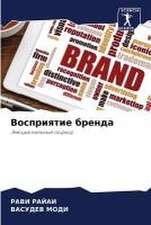The Artification of Luxury Fashion Brands: Synergies, Contaminations, and Hybridizations: Palgrave Studies in Practice: Global Fashion Brand Management
Editat de Marta Massi, Alex Turrini Cuvânt înainte de Jean-Noël Kapfereren Limba Engleză Paperback – 26 aug 2021
| Toate formatele și edițiile | Preț | Express |
|---|---|---|
| Paperback (1) | 479.67 lei 6-8 săpt. | |
| Springer International Publishing – 26 aug 2021 | 479.67 lei 6-8 săpt. | |
| Hardback (1) | 390.51 lei 3-5 săpt. | +20.88 lei 7-13 zile |
| Springer International Publishing – 19 iun 2020 | 390.51 lei 3-5 săpt. | +20.88 lei 7-13 zile |
Preț: 479.67 lei
Nou
91.78€ • 95.83$ • 75.96£
Carte tipărită la comandă
Livrare economică 05-19 aprilie
Specificații
ISBN-10: 3030261239
Pagini: 166
Ilustrații: XVII, 166 p. 15 illus., 3 illus. in color.
Dimensiuni: 148 x 210 mm
Greutate: 0.23 kg
Ediția:1st ed. 2020
Editura: Springer International Publishing
Colecția Palgrave Pivot
Seria Palgrave Studies in Practice: Global Fashion Brand Management
Locul publicării:Cham, Switzerland
Cuprins
Sections
Topics
Potential authors
Foreword
The artification of luxury
François Colbert, Full Professor, HEC Montreal
Introductory section
Preface
The introduction will present the subject and the structure of the book, and will make the case for the study of the relationship between art and fashion. It will offer a review of the various contributions in order to provide context and offer the interpretation key to the book.
Marta Massi, Assistant Professor, Università Cattolica del Sacro Cuore;
Alex Turrini, Associate Professor, Southern Methodist University, TX, USA
Chapter 1 - When Fashion Met Arts: The Artification of Fashion Brands
Chapter 1 will review the literature on the artification of fashion in order to illustrate how two apparently separated worlds, such as art and fashion, are increasingly interacting and collaborating to achieve mutual benefits.
This introductory chapter will provide the theoretical foundation to analyze the cases of art/fashion collaboration. It will also outline the main strategies used by fashion firms, i.e., 1) corporate art collections; 2) corporate museums; 3) exhibits and installations; 4) Mecenatism (support to artists or creation of foundations); 5) sponsorships and cobranding; 6) art-based fashion brand management.
Marta Massi, Assistant Professor, Università Cattolica del Sacro Cuore;
Alex Turrini, Associate Professor, Southern Methodist University, TX, USA
Part 1 - Art & Fashion Synergies
Chapter 2 – Brunello Cucinelli, a humanistic approach to fashion
Chapter 5 will focus on Brunello Cucinelli. Founded in 1978, Brunello Cucinelli has been the subject of significant interest in recent years in connection with its ability to continue to growth its brand in an ongoing connection with arts and culture. Cucinelli represents an example of “employee-centered approach humanistic capitalism.” Based in Solomeo in Central Italy, where it founded the School for Arts and Craft, the company identifies its truest meaning and aesthetic research in manual work and craftsmanship, the most authentic expressions of people’s humanity and creativity.
Chiara Paolino, Assistant Professor, Università Cattolica del Sacro Cuore
Ariane Berthoin Antal, Research Fellow, WZB Berlin Social Science Center
Part 2 – Art & Fashion Contaminations
Chapter 3 - Trussardi and the art of promoting art
Chapter 3 will look at Trussardi, a brand that has showed a consistent link to the arts. In particular, it will focus on Fondazione Trussardi, an institution aimed at the promotion of contemporary art; a nomadic museum for the production and spreading of art in multiple contexts and through different channels.
François Colbert, Professor, HEC Montreal; Andrea Rurale, Lecturer, Bocconi University
Chapter 4 – Gucci: Branding art or art branding?
Chapter 4 will deal with Gucci, a brand that has held a fructuous collaboration with artists, created its own museum and used arts in and out its stores (e.g., Gucci Walls; Gucci Art Lab). The connection of Gucci to the arts is also fostered by the ownership of the company by Francois Pinault, who developed Palazzo Grassi and Punta della Dogana in Venice.
Paul Harrison, Senior Lecturer, Deakin University, Australia, Alessia Anzivino, Research Associate, Università Cattolica del Sacro Cuore, Giorgia Sepe, Research Associate, Università Cattolica del Sacro Cuore
Part 3 – Art & Fashion Hybridizations
Chapter 5 - Christian Dior: The Art of Haute Couture
Chapter 2 will focus on Christian Dior, a company that has invested many resources in the collaboration with the arts, from the creation of the museum to development of exhibits such as House of Dior: Seventy Years of Haute Couture, a collaboration with the National Gallery of Victoria, Australia, which displayed more than 140 garments designed by Christian Dior Couture between 1947 and 2017.
Federica Antonaglia, IAE - Enseignant Chercheur, Université de Bordeaux
Juliette Passebois, IAE - Enseignant Chercheur, Université de Bordeaux
Chapter 6 – Balenciaga, the Master of Haute Couture
Chapter 6 will deal with Balenciaga, a brand that carries the name of the designer known as ‘The Master’ of haute couture, one of the most revered and influential fashion designers of the 20th century. Characterized by their sculptural quality, deft manipulation of textiles and dramatic use of color and texture, Balenciaga creations are inspired by artworks and can be admired at the Balenciaga Museum.
Manuel Cuadrado, Associate Professor, Universitat de Valencia, Spain.
Piergiacomo Mion, SDA Fellow, Bocconi University
Chiara Piancatelli, SDA Fellow, Bocconi University
Conclusions
This conclusive chapter will outline the main managerial implications emerging from the analysis of the case studies and set the ground for future research in the field.
Marta Massi, Assistant Professor, Università Cattolica del Sacro Cuore;
Alex Turrini, Associate Professor, Southern Methodist University, TX, USA
Notă biografică
Marta Massi is Lecturer of Marketing at McGill University, Canada. She has previously served as Assistant Professor of Marketing at Università Cattolica del Sacro Cuore, Italy and a visiting scholar at Deakin University, Australia. Her research interests include branding and arts and culture marketing. Her work has been published in national and international journals, including Journal of Global Marketing, Journal of Consumer Affairs and International Journal of Technology Management.
Alex Turrini is Associate Professor of Arts Management and Cultural Policy at Bocconi University, Italy. He has been Director of the SMU Meadows Division of Arts Management and Arts Entrepreneurship as well as visiting professor of Arts Management and Cultural Policy at SMU Meadows and Cox School of Business, USA. He carried forward several research, training and consulting projects with different national and international public sector organizations involved in the arts. His research activities center on public policies and management in the arts and cultural sector, arts collecting behavior and inter-organizational networks in the arts.
Textul de pe ultima copertă
Despite being vastly different both socially and economically, art and fashion are increasingly converging to collaborate in mutually advantageous ways. This book discusses the mutual benefits of collaboration through analysis of successful case studies, including corporate art collections and museums, patronage and sponsorship initiatives, and art-based brand management in the fashion sector. It provides a categorization of the strategies that fashion firms employ when they join the art world and illustrates how art and fashion brands can interact strategically at different levels. This book will be a valuable resource to researchers, providing an enhanced understanding of the potential of artification for managing brands and products.
Caracteristici
Offers a new perspective on the hybridization and synergies between fashion and art from a business point of view, overcoming the sociological perspective from which these phenomena are usually looked at
Brings together fashion and arts scholars to provide insights into pros and cons of the collaborations between art and fashion
Descriere
Despite being vastly different both socially and economically, art and fashion are increasingly converging to collaborate in mutually advantageous ways. This book discusses the mutual benefits of collaboration through analysis of successful case studies, including corporate art collections and museums, patronage and sponsorship initiatives, and art-based brand management in the fashion sector. It provides a categorization of the strategies that fashion firms employ when they join the art world and illustrates how art and fashion brands can interact strategically at different levels. This book will be a valuable resource to researchers, providing an enhanced understanding of the potential of artification for managing brands and products.


















